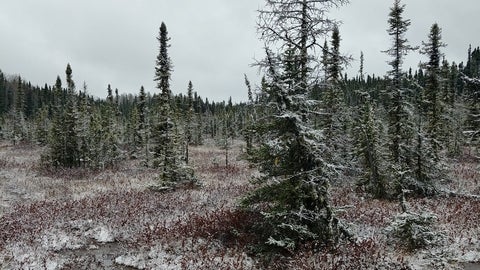Can-Peat: Canada's peatlands as nature-based climate solutions
The Importance of our Peatlands
Peatlands are wetland ecosystems that have accumulated an organic layer at least 40 cm thick in their soils. This organic matter accumulates due to the slow decomposition of relatively decay-resistant litter in water-saturated, anoxic soils, often under cool temperatures when occurring at high latitudes. These anoxic conditions also lead to the production of the greenhouse gas methane, with northern peatlands representing up to 10% of global methane emissions. Although emissions of another important greenhouse, nitrous oxide, are generally low, particularly in nutrient-poor sites, emissions may increase with climate change, especially as permafrost thaws in peatlands. The organic matter stored in peatlands represents a large stock of soil carbon that has been slowly accumulating over millennia, resulting in atmospheric cooling even once methane emissions are accounted for.
In Canada there is over 1.13 million km2 of peatland area, accounting for approximately 12% of the land area and representing a quarter of all global peatlands. Much of the peatlands in Canada are located in the lands and traditional territories of many Indigenous Nations. Peatlands have been safeguarded by these communities since time immemorial, and continue to be protected by Indigenous Peoples. The wide wealth of knowledge that Indigenous Peoples have acquired on peatlands in Canada is important to the future conservation of these areas. Due to this, the inclusion of Indigenous communities in the Can-Peat project is necessary for the success of the project.
Peatlands are a critical part of our landscape and represent a substantial portion of the country’s nature-based carbon stocks. The goal of Can-Peat is to quantify the potential for peatland management in Canada to contribute to nature-based solutions to climate change.
Open to Collaborate

Our research team is committed to the development of new modes of collaboration, engagement, and partnership with Indigenous peoples for the care and stewardship of past and future heritage collections.
For more information about this Notice, visit localcontexts.org
Can-Peat Objectives
Over the next five years, Can-Peat will quantify the potential of peatland management in Canada to contribute to climate change mitigation. The research supports Canada's commitment to reach net-zero emissions economy by 2050. Specific objectives are to:
- Create a Canada-wide peatland research network
- Compile a database on peatland carbon stocks, greenhouse gas exchange, and supporting data across Canada
- Advance models of peatland carbon cycling from site to national scale and use these models to evaluate future peatland greenhouse gas uptake or emission under changing climate and disturbance regimes
- Investigate mechanisms to implement peatland nature-based solutions in Canada and develop a decision-support framework for peatland management
- Communicate findings to partners and provide the tools needed for climate-friendly peatland management and greenhouse gas emission reporting related to these activities.
Can-Peat: Canada's peatlands as nature-based climate solutions is funded through the Government of Canada’s Environmental Damages Fund. Administered by Environment and Climate Change Canada, $15.8 million is being allocating to six University of Waterloo research projects to identify solutions to environmental challenges. Nationally the Climate Action Awareness Fund was part of a $58 million announcement by Minister Guilbeault for research projects that will advance science and technology to combat climate change.



